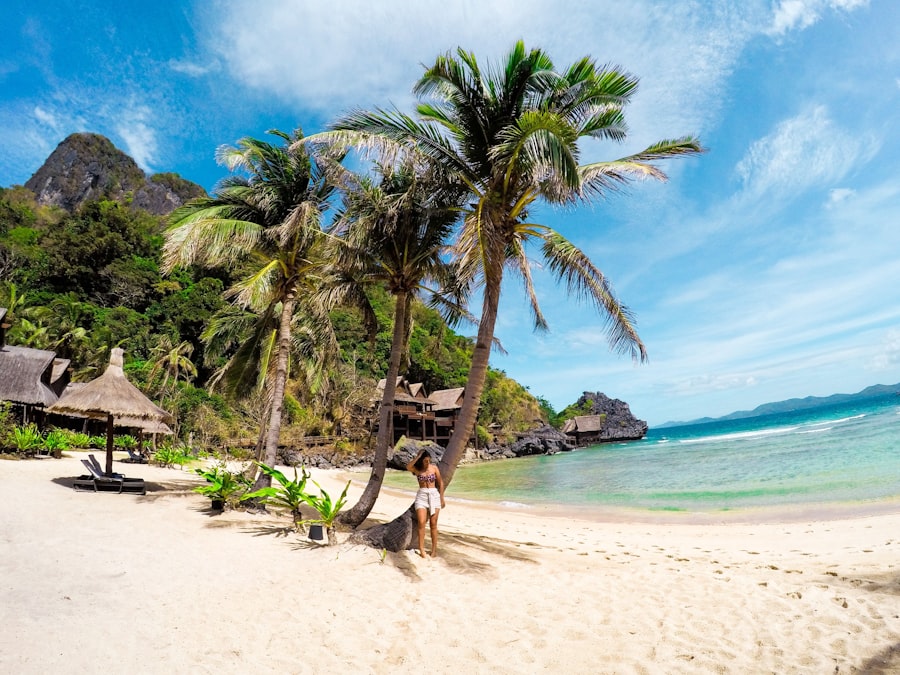Download links
How to install Discovering the Wonders of Palawan APK?
1. Tap the downloaded Discovering the Wonders of Palawan APK file.
2. Touch install.
3. Follow the steps on the screen.
Description
Palawan, often referred to as the “Last Frontier” of the Philippines, is an archipelago that captivates visitors with its stunning landscapes and rich biodiversity. Stretching over 1,800 kilometers, this province is home to a myriad of islands, each offering unique experiences and breathtaking views. The capital city, Puerto Princesa, serves as the gateway to the region’s natural wonders, including the famous Puerto Princesa Subterranean River National Park, a UNESCO World Heritage Site.
The island’s strategic location between the South China Sea and the Sulu Sea has made it a melting pot of cultures, with influences from various ethnic groups and a history that dates back centuries. The allure of Palawan lies not only in its picturesque scenery but also in its commitment to preserving its natural environment. The province boasts some of the most pristine beaches, lush jungles, and vibrant coral reefs in the world.
As tourism continues to grow, Palawan faces the challenge of balancing development with conservation, making it a focal point for eco-tourism and sustainable practices. This article delves into the natural wonders, marine life, indigenous culture, adventure opportunities, culinary delights, conservation efforts, and practical tips for exploring this enchanting destination.
Key Takeaways
- Palawan is a stunning island province in the Philippines known for its natural beauty and rich biodiversity.
- The natural wonders of Palawan include the UNESCO World Heritage-listed Puerto Princesa Subterranean River National Park and the breathtaking limestone cliffs of El Nido.
- Palawan is home to diverse marine life and vibrant coral reefs, making it a paradise for snorkeling and diving enthusiasts.
- The indigenous culture and traditions of Palawan are celebrated through colorful festivals, traditional crafts, and unique culinary offerings.
- Adventure and eco-tourism activities in Palawan range from island hopping and kayaking to jungle trekking and wildlife spotting.
Natural Wonders of Palawan
Palawan’s natural wonders are nothing short of extraordinary. The landscape is characterized by dramatic limestone cliffs, crystal-clear waters, and lush tropical forests. One of the most iconic sites is El Nido, known for its stunning lagoons and hidden beaches.
The Big Lagoon and Small Lagoon are particularly famous for their turquoise waters surrounded by towering limestone formations. Visitors can kayak through these lagoons, exploring the intricate network of caves and coves that make up this breathtaking area. The beauty of El Nido is complemented by its diverse ecosystems, which include mangroves, coral reefs, and rich marine life.
Another remarkable feature of Palawan is the Underground River in Puerto Princesa.
The journey through the river reveals impressive stalactites and stalagmites, as well as unique rock formations that have been shaped over thousands of years.
The surrounding area is equally captivating, with dense forests that are home to various species of flora and fauna. The combination of geological wonders and ecological diversity makes Palawan a paradise for nature lovers and adventure seekers alike.
Marine Life and Coral Reefs

The waters surrounding Palawan are teeming with life, making it a premier destination for snorkeling and diving enthusiasts. The Tubbataha Reefs Natural Park, another UNESCO World Heritage Site, is renowned for its vibrant coral reefs and diverse marine ecosystems. This remote marine sanctuary is home to an astonishing variety of species, including over 600 species of fish, 360 species of coral, and numerous sea turtles and sharks. The park’s isolation has allowed its ecosystems to thrive, providing a glimpse into what marine environments looked like before human intervention. In addition to Tubbataha, other notable diving spots include Coron and Apo Reef.
Coron is famous for its World War II shipwrecks that attract divers from around the globe. These wrecks have become artificial reefs, fostering a rich marine habitat that supports an array of marine life. Apo Reef, on the other hand, is one of the largest contiguous coral reefs in the Philippines and offers stunning underwater landscapes filled with colorful corals and diverse fish species. The health of these reefs is crucial not only for marine biodiversity but also for local communities that rely on fishing and tourism for their livelihoods.
Indigenous Culture and Traditions
| Indigenous Culture and Traditions | Metrics |
|---|---|
| Population | Estimated number of indigenous people |
| Languages | Number of indigenous languages spoken |
| Cultural Practices | Traditional ceremonies, dances, and rituals |
| Art and Crafts | Types of traditional art and crafts |
| Land Rights | Extent of indigenous land ownership and rights |
Palawan is home to several indigenous groups, each with its own unique culture and traditions. The Tagbanua people are one of the most prominent indigenous communities in the region. They have lived in harmony with nature for centuries, practicing sustainable fishing and farming methods that reflect their deep respect for the environment.
The Tagbanua have a rich oral tradition that includes stories about their ancestors and the spirits of nature, which they believe play a significant role in their daily lives. Another indigenous group is the Batak people, who inhabit the mountainous areas of northern Palawan. The Batak have a distinct way of life that revolves around hunting, gathering, and subsistence farming.
Their traditional practices include crafting intricate woven baskets and using medicinal plants for healing purposes. Visitors to Palawan can engage with these communities through cultural tours that promote understanding and appreciation of their heritage while supporting their livelihoods. Such interactions provide valuable insights into how indigenous cultures adapt to modern challenges while preserving their unique identities.
Adventure and Eco-Tourism
For those seeking adventure, Palawan offers an array of activities that cater to thrill-seekers and nature enthusiasts alike. Island hopping is one of the most popular activities, allowing visitors to explore hidden beaches, lagoons, and snorkeling spots across various islands. Each island presents its own unique charm; for instance, Cowrie Island is known for its white sandy beaches and vibrant marine life, while Matinloc Island features dramatic cliffs and secluded coves.
Trekking through the lush jungles of Palawan also provides an exhilarating experience. Trails lead to stunning viewpoints overlooking the sea or hidden waterfalls where travelers can take a refreshing dip. The Puerto Princesa Subterranean River National Park offers guided treks that combine adventure with education about the region’s biodiversity.
Eco-tourism initiatives in Palawan emphasize responsible travel practices that minimize environmental impact while promoting conservation efforts. By participating in these activities, visitors contribute to local economies while fostering a greater appreciation for nature.
Culinary Delights of Palawan

Palawan’s culinary scene reflects its rich cultural heritage and abundant natural resources. Seafood plays a central role in local cuisine due to the province’s proximity to the ocean. Fresh catches such as fish, crabs, and shrimp are often prepared using traditional methods that highlight their natural flavors.
One must-try dish is “Tamilok,” a delicacy made from woodworms found in mangrove trees. While it may sound unusual to some, Tamilok is often enjoyed raw with vinegar or calamansi juice, offering a unique taste experience.
Dishes like “Kare-Kare,” a rich oxtail stew served with peanut sauce, showcase Filipino flavors while reflecting regional variations. Street food is also prevalent in Palawan’s markets; visitors can sample local favorites such as “lumpiang shanghai” (spring rolls) or “balut” (fertilized duck egg) for an authentic taste of Filipino culture. Dining in Palawan often takes place against stunning backdrops—whether on a beach at sunset or in a rustic eatery surrounded by nature—enhancing the overall culinary experience.
Conservation Efforts in Palawan
As tourism continues to grow in Palawan, so does the need for effective conservation efforts to protect its unique ecosystems. Various organizations and local government initiatives are working tirelessly to promote sustainable practices that safeguard both natural resources and local communities’ livelihoods. One notable effort is the establishment of marine protected areas (MPAs) throughout the province.
These MPAs help preserve critical habitats while allowing fish populations to recover from overfishing. Community-based conservation programs also play a vital role in protecting Palawan’s biodiversity. Local residents are often engaged in conservation activities that empower them to take ownership of their natural resources.
For instance, initiatives that promote sustainable fishing practices not only help maintain fish stocks but also provide alternative livelihoods for fishermen who may otherwise rely on destructive fishing methods. Education campaigns aimed at raising awareness about environmental issues further contribute to fostering a culture of conservation among both locals and visitors.
Tips for Exploring Palawan
Exploring Palawan requires some planning to ensure an enjoyable experience while respecting its natural beauty and cultural heritage. First and foremost, travelers should consider visiting during the dry season from November to May when weather conditions are most favorable for outdoor activities. Booking accommodations in advance is advisable during peak tourist seasons to secure preferred lodging options.
When island hopping or engaging in water activities, it’s essential to choose eco-friendly tour operators who prioritize sustainable practices. This includes using non-motorized boats when possible and adhering to guidelines that protect marine life during snorkeling or diving excursions. Additionally, travelers should be mindful of their waste by bringing reusable water bottles and avoiding single-use plastics.
Engaging with local communities can enrich one’s travel experience significantly; however, it’s crucial to approach these interactions respectfully. Learning about indigenous cultures through guided tours or workshops can provide valuable insights while supporting local economies. Lastly, taking time to appreciate Palawan’s natural wonders—whether through leisurely hikes or quiet moments on secluded beaches—will create lasting memories of this extraordinary destination.
If you’re planning a trip to Palawan, you might also be interested in checking out the article on the B612 Selfiegenic Camera 2, which offers tips on capturing the perfect selfie while exploring the beautiful landscapes of the Philippines. You can read more about it here.
FAQs
What is Palawan?
Palawan is an island province in the Philippines located in the Mimaropa region. It is known for its stunning natural beauty, including pristine beaches, crystal-clear waters, and lush forests.
What are the popular tourist attractions in Palawan?
Some of the popular tourist attractions in Palawan include the Puerto Princesa Subterranean River National Park, El Nido, Coron, and the Tubbataha Reefs Natural Park. These destinations offer opportunities for diving, snorkeling, island hopping, and exploring natural wonders.
What is the climate like in Palawan?
Palawan has a tropical climate with two distinct seasons: the dry season from November to May and the wet season from June to October. The average temperature ranges from 25°C to 32°C throughout the year.
How do I get to Palawan?
The main gateway to Palawan is through the Puerto Princesa International Airport, which is serviced by domestic and international flights. There are also ferry services from Manila and other nearby islands to Palawan.
Is Palawan safe for tourists?
Palawan is generally considered safe for tourists. However, it is always advisable to take standard precautions and be mindful of local customs and regulations. It is also recommended to check travel advisories before visiting.





